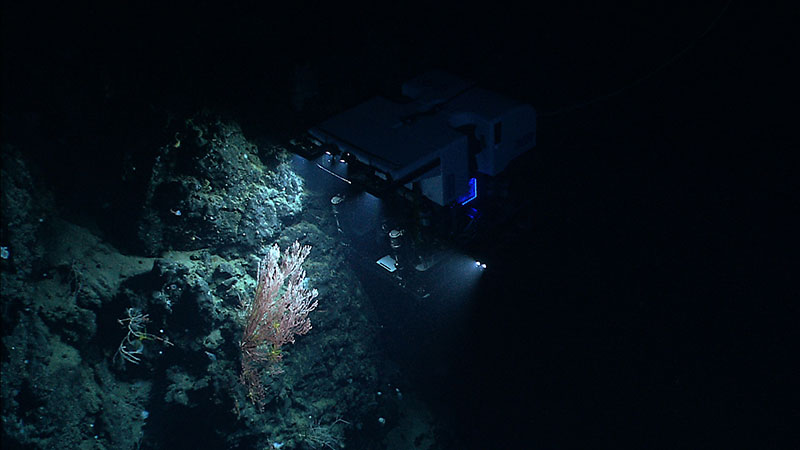Dive 04 took us to Mytilus Seamount, one of the least explored seamounts of the New England Seamount Chain. The dive started late after an issue with the traction winch that required maintenance. While the remotely operated vehicle (ROV) descended to the seafloor, there were very few planktonic organisms observed. The ROV reached the bottom at a depth of 3,271 meters. The dive track ascended a steep portion along the north side of the seamount, from ~3,270 to 2,750 meters. The geology was characterized by a combination of gentle and steeply sloping basalt pillars that were smooth in texture, interspersed with ledges or steps covered with sediment drape. Periodically, piles of small, dark rocks were observed. All the rocks had a manganese coating. At the start of the dive, various sponges, mostly glass sponges of different forms, populated the rock walls. These included long stalked forms with a “tulip “shaped head, vases, “witches” hat, globular, and “rose” shaped. Various species of brittle stars, stalked and non-stalked crinoids, and sea cucumbers were abundant along the rock walls and on the sediment ledges throughout the dive. At around 3,250 meters, the first corals were observed. As the ROV continued up slope, additional corals, including a few different species of bamboo corals as well as Chrysogorgia, Paragorgia, Paranarella, Anthomastus, Corallium, Convexella, and two black coral species were noted. No scleractinian corals were documented on the dive. Other fauna observed included hermit crabs, squat lobsters, the coral-eating seastar, several bryozoans, two featherduster polychaete worms, and barnacles. At 2,806 meteres, a large bamboo coral colony with associated crinoids was imaged. Several large bamboos were documented throughout the remainder of the dive. At the end of the dive, a pillow lava was observed. Very few fish, including a frogfish, cusk eel, and synaphobranchid eel, were documented.. Our dive at Mytilus Seamount represents the most comprehensive investigation of benthic communities at this seamount to date.
